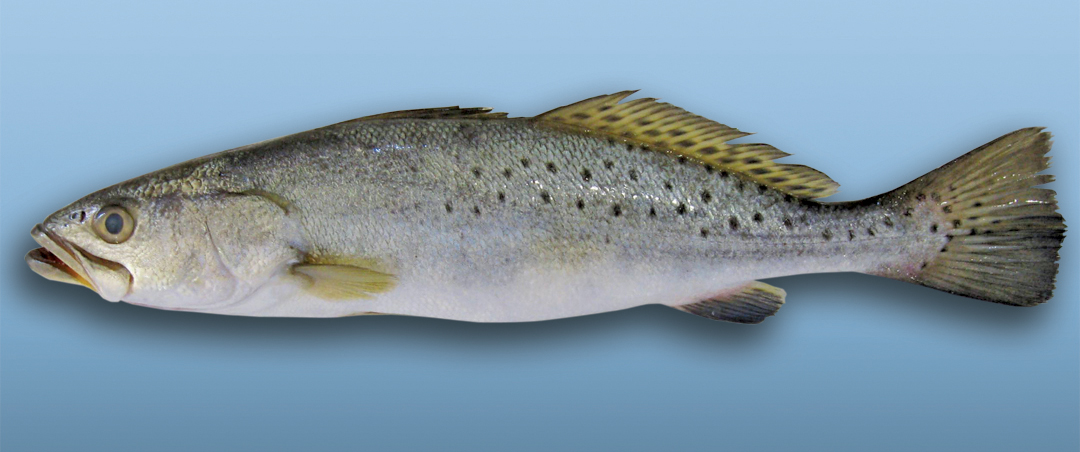Center for Fisheries Research and Development
Spotted Seatrout Tag and Release
Page Content
Spotted Seatrout
Cynoscion nebulosus
Common names: Spotted Seatrout, speckled trout, speck
Order: Perciformes
Family: Sciaenidae (Drum family)
Spotted seatrout are routinely called speckled trout or specks. Spotted Seatrout have an elongated, streamlined body with a slightly elevated back, long pointed head, and oblique mouth with the lower jaw extending beyond the upper. They are silvery gray or greenish on the upper sides and back, shading to white on the belly. The upper back has an iridescent sheen with light blue and purple. Dark spots appear on the upper portion of the sides and on the dorsal fin and tail. The dorsal fin and tail are dusky, and the tail is edged in black. The other fins are pale or yellowish. The overall coloration varies with water conditions, with fish from stained inshore water typically being darker and even somewhat golden.
The mouth often shows yellow coloration on the edges and interior, especially in older fish. There are one or two prominent canine teeth at the front of the upper jaw. The dorsal fin is long and separated by a deep notch into a spiny forward section and a soft rear section. Like other fish in the drum family (e.g., Red Drum, Black Drum, Sand Seatrout, Ground Mullet, Croaker, Spot...), the lateral line extends onto the tail. Occasionally, a "spotless speck" is encountered with no spots on the body; however, the tail and dorsal fin are always spotted. A six-pound Spotted Seatrout is considered large, and ten pounders are occasionally caught. Female Spotted Seatrout can live to age ten, but few males live beyond 5 years of age. Consequently, fish weighing five pounds or more are typically female. Large fish (longer than 22" in length) are sometimes described as "gator trout." Large gravid (with eggs) females are often referred to as "sow trout."
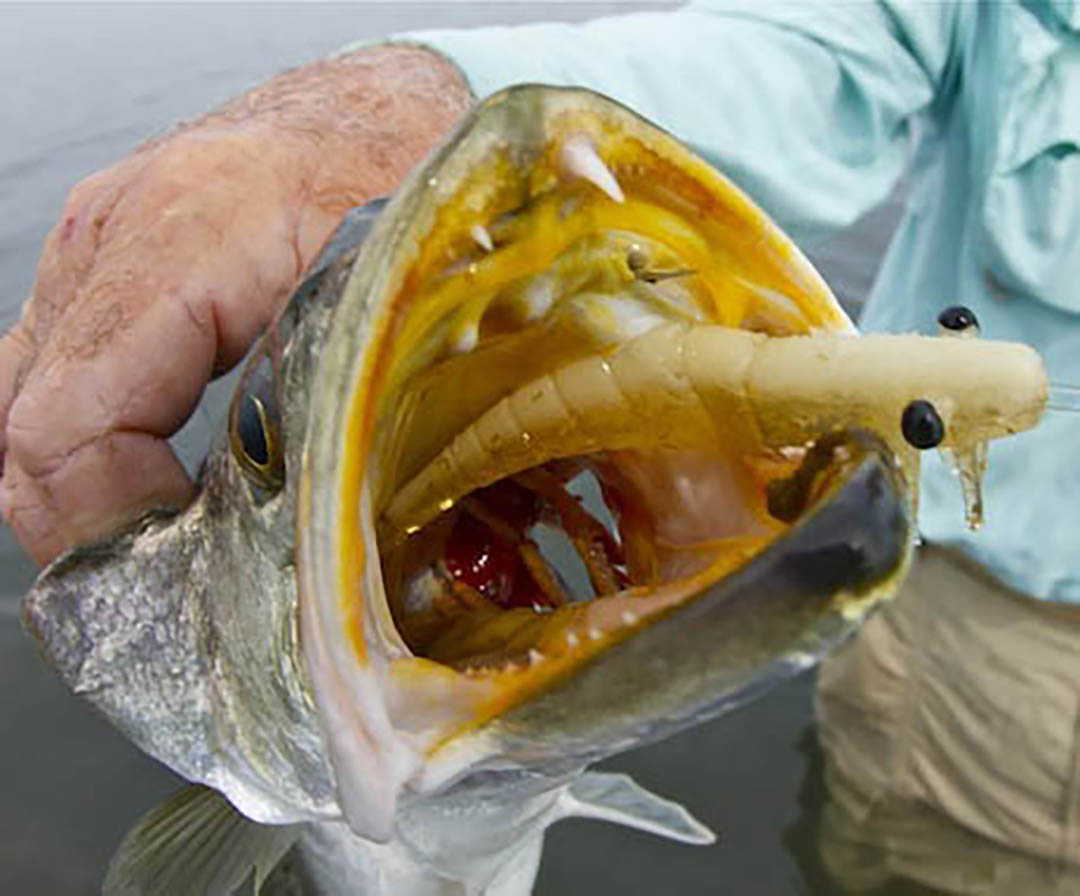
Photo provided by Captain John Kumiski, Spotted Tail Fishing Charter Service.
______________________________
The nickname "yellowmouth" comes from the yellow interior of the mouth which is observed more often in larger fish. The Spotted Seatrout's relatively delicate mouth structure sometimes allows a hook to break free and earns the fish the nickname "papermouth." Spotted Seatrout are similar to two other saltwater trout species but are easily distinguished by their spots. Sand Seatrout, or white trout Cynoscion arenarius, and the smaller Silver Seatrout Cynoscion nothus look much like Spotted Seatrout but have no spots. The weakfish, Cynoscion regalis, has spots on its body, but none on the fins or tail. Weakfish are not found in the Gulf of Mexico.
Occurrence
The range of Spotted Seatrout extends from Cape Cod to both coasts of Florida and throughout the entire Gulf of Mexico, but they are most common along the northern Gulf of Mexico and the Florida Gulf coast. In Mississippi, they are found from nearly fresh water in upper estuaries, throughout the Mississippi Sound, and out to water depths of ~30 feet in the Gulf.
Most Spotted Seatrout spend their entire lives in or near the estuary in which they were spawned. In an volunteer angler-based sport fish tag and release study conducted by the CFRD on Spotted Seatrout in Mississippi coastal waters during the 1990’s, 221 of the 7,423 Spotted Seatrout tagged and released during years of the study were recaptured, with 90% of those recaptured within five miles of their tag-release location. A tagging study in Alabama showed that 53% of tagged Spotted Seatrout fish exhibited no movement, while the longest distance traveled by any fish was less than 20 miles. Similar results have been found from studies in Louisiana and Florida. However, a few individual Spotted Seatrout do occasionally move substantial distances, e.g., one fish tagged in the Apalachicola, Florida area was recovered near Grand Isle, Louisiana.
Spotted Seatrout are a schooling species, particularly when they are young. They favor locations where there are current discontinuities, such as mouths of water bodies, gullies and trenches, sharp bends, and changes in bottom contour. They are not particularly attracted to hard bottoms but are often found near seagrasses and saltmarshes adjacent to deep channels.
During the pre-spawning period of February to early April, Mississippi Spotted Seatrout are ‘scattered’ throughout their home range, but by mid-April, fish old enough to spawn typically move to the higher salinity waters of the lower bays, where they remain throughout the spawning season. As cool fronts arrive in the fall, they move into lower-salinity estuaries, bayous, and the lower portions of rivers, often seeking warmer water temperatures in deep holes (thermal refuge) during cold weather. Similarly, Spotted Seatrout may take refuge in cooler deep water during extremely hot weather.
Biological Research
Growth rates vary with location and conditions, but at the end of their first year of life Spotted Seatrout are typically 10" long. It takes generally up to two years to reach 12" in length, and two to three years to reach 16" in length. Female Spotted Seatrout can live 10 to 12 years, though rarely. Most Spotted Seatrout caught by anglers are no more than four or five years of age.
A study showed that about 30% of Mississippi female Spotted Seatrout reach sexual maturity at a length of 11". The fraction of sexually mature females increases to 43% at 12" and 66% at 13". 100% of females are capable of spawning at a length of 14". Males mature at a much smaller size. The number of eggs released during each spawning event increases substantially as the females grow older. A five-year old female can produce about five times as many eggs per spawning season as a one-year old.
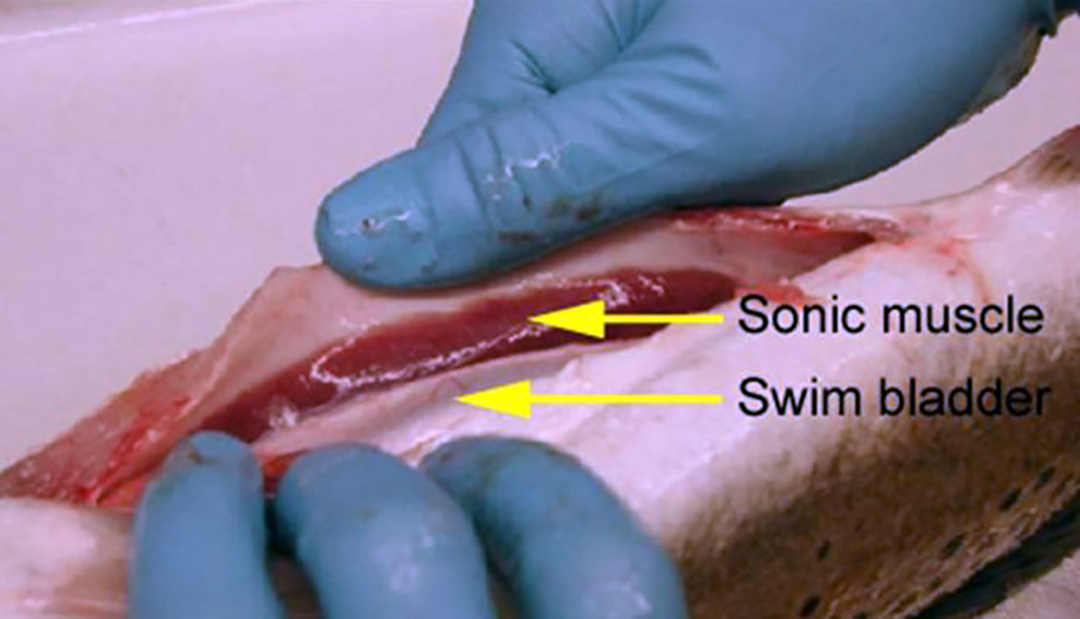
The sonic muscle is a specialized muscle that vibrates against the swim bladder to
produce sound used to attract females during the spawning season. Photo Credit: Florida
Fish and Wildlife Research Institute.
______________________________
The name "drum" for this family of fish comes from the ability of the male to produce a deep drumming sound that is used during courtship and sometimes when a fish is distressed. Spawning takes place in nearshore and estuarine waters and begins when water temperature and salinity are favorable (77 to 86 oF and 17 - 35 ppt). Male Spotted Seatrout aggregate where there is good tidal current flow, in shallow bays and lagoons, or deeper channels and depressions close to grass flats, and “drum” to attract females. The drumming sound is accomplished by the contraction of sonic muscles on either side of the swim bladder. Males begin drumming near sunset and spawning activity usually continues until about midnight. Female Spotted Seatrout are broadcast spawners, and males immediately fertilize the eggs as females broadcast (release) them into the water.
The spawning season for Spotted Seatrout in Mississippi is shorter than for other areas of the Gulf Coast, and the number of eggs produced per spawning event is lower. In coastal Mississippi, Spotted Seatrout spawn over a five-month period from mid-April to mid-September, with some slight variation in the timing of the spawning season from year to year, depending on water temperature. Spotted Seatrout are capable of spawning 1,000s of eggs multiple times throughout the reproductive season. An average two-year-old Spotted Seatrout in Mississippi can release three to five million eggs per season. Research conducted on Spotted Seatrout from Mississippi waters indicated that females collected from around the offshore barrier islands and St. Louis Bay spawned more frequently (about every four days) than fish examined from Biloxi Bay (spawned every 15-18 days).
Spotted seatrout eggs are spherical, measuring approximately 1/32" in diameter (0.70-0.98 mm), and contain million one to four oil droplets. About 18 hours after fertilization, eggs hatch into larvae about 1/16" long (1.3-1.6 mm). The larvae take refuge in bottom vegetation or shell rubble to avoid predators. At 6-8 weeks of age the young fish have reached a length of one to two inches (25-50 mm in length) and begin to form schools of perhaps up to 50 individuals. As Spotted Seatrout mature, juveniles move to seagrass beds, sandy bottoms, muddy bottoms, and shell reefs where they continue their lives as adults.
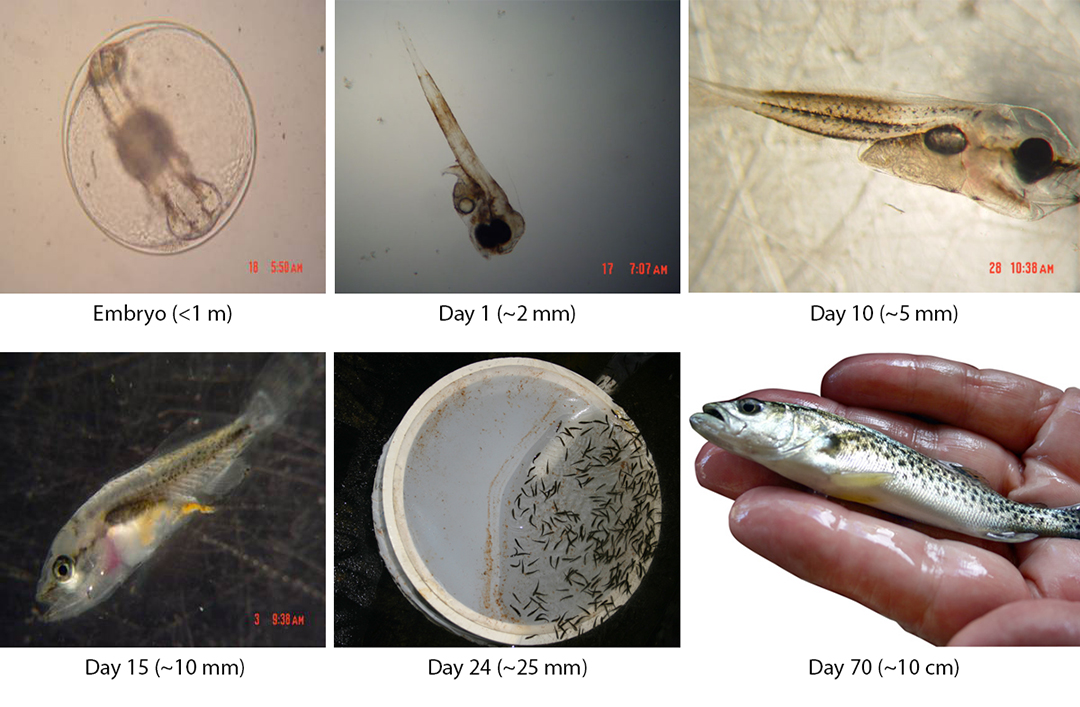
Growth and Development of Aquacultured Spotted Seatrout: The University of Southern Mississippi Thad Cochran Marine Aquaculture Center. TCMAC photos.
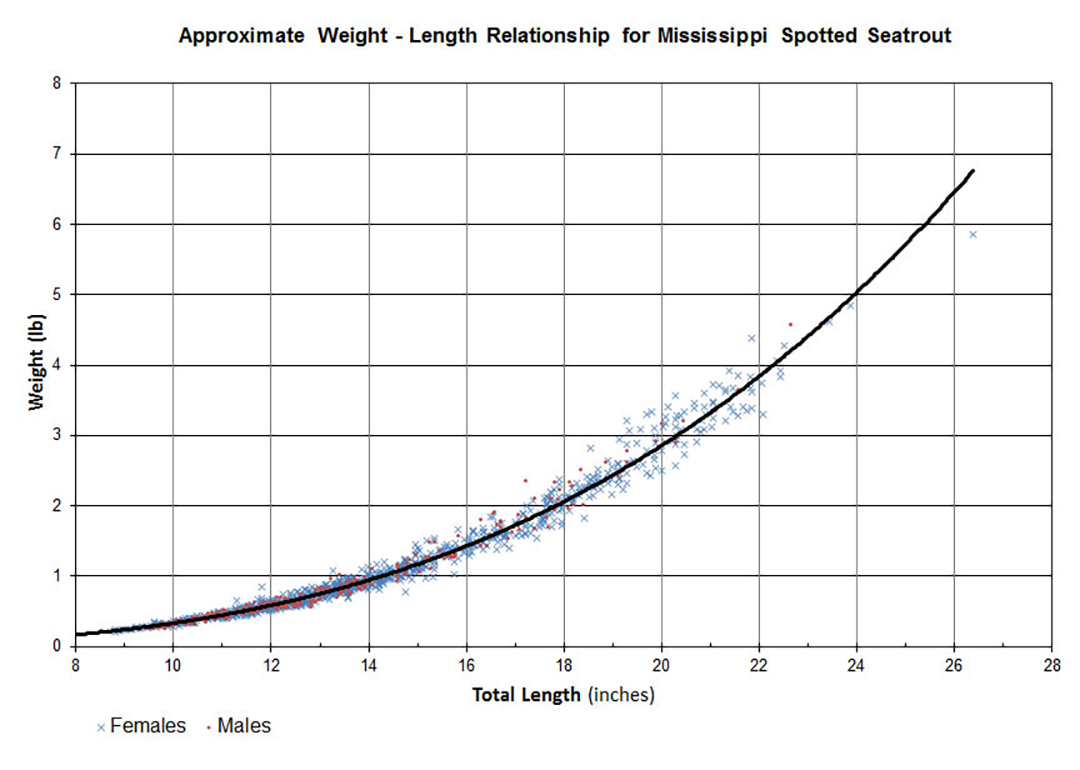 Larger fishes are the primary predators on Spotted Seatrout, however, bottlenose dolphins
and predatory birds such as ospreys, cormorants and pelicans also feed on Spotted
Seatrout.
Larger fishes are the primary predators on Spotted Seatrout, however, bottlenose dolphins
and predatory birds such as ospreys, cormorants and pelicans also feed on Spotted
Seatrout.
Larger fishes are the primary predators on Spotted Seatrout. Bottle nosed dolphins and predatory birds such as ospreys, cormorants, and pelicans also predators.
Management
Spotted Seatrout are managed in each Gulf and South Atlantic state by specific catch/harvest regulations. In Mississippi waters, Spotted Seatrout are managed as a single stock. Recreational limits are a minimum total length of 15 inches and 15 fish/person daily possession. The commercial harvest is regulated by a minimum total length of 14 inches and a total allowable catch (TAC) quota of 50,000 pounds per year.
